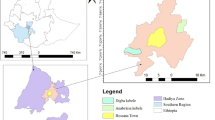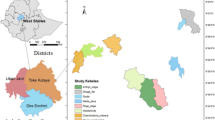Abstract
Understanding the performance of agroforestry woody species in controlled and free grazing systems is crucial for scaling up agroforestry practices. The objective of this study was to identify and evaluate the determinants of agroforestry woody species composition and regeneration in free and controlled grazing systems in the Ethiopian highlands. Household and field surveys were conducted on 83 and 171 households selected from controlled grazing (CG) and free grazing (FG) systems, respectively. Woody species performance was compared between the two grazing systems using independent T-test. Seemingly unrelated regression (SUR) was used to identify the factors determining woody species density/abundance, diversity and regeneration. Most trees were grown for fuel wood and timber rather than for fodder. CG users owned more diversified species and abundant regenerates and mature trees/shrubs than FG users. The SUR results showed that herd size, farmland size, fencing, plantation of seedlings, education, wealth, grazing system, farmland distance from homestead and slope were the major factors affecting the composition and regeneration of species. Specifically the SUR results per-household indicated that woody species regeneration was highly affected by grazing system. Fencing is the common underlying factor positively affecting species diversity, regeneration and density of mature trees. Homestead distance from road and number of planted seedlings significantly affected density of regenerates and mature trees. Density of mature trees and species diversity were significantly affected by agroecology and slope. Woody species diversity was significantly affected by education, wealth, farmland size and project participation. Our findings revealed that the scaling up of woody species in agroforestry requires not only CG and favorable agroecology but also matching of agroforestry options with household and farmland characteristics.






Similar content being viewed by others
References
Abiyu A, Teketay D, Gratzer G, Shete M (2015) Tree planting by smallholder farmers in the upper catchment of Lake Tana Watershed, Northwest Ethiopia. Small-scale For. https://doi.org/10.1007/s11842-015-9317-7
Alemu B, Kidane D (2014) The Implication of integrated watershed management for rehabilitation of degraded lands: case study of Ethiopian highlands. J Agric Biodivers Res 3(6):78–90
Amare D, Wondie M, Mekuria W, Darr D (2018) Agroforestry of smallholder farmers in Ethiopia: practices and benefits. Small-Scale For 17(3):1–18
Abebe TA, Sterck FJ, Wiersum KF, Bongers F (2013) Diversity, composition and density of trees and shrubs in agroforestry homegardens in Southern Ethiopia. Agrofor Syst 87:1283–1293
Baudron F, Mamo A, Tirfessa D, Argaw M (2015) Impact of farmland exclosure on the productivity and sustainability of mixed crop-livestock system in central rift valley, Ethiopia. Agric, Ecosyst Environ 207:109–118
Birhane E, Teketay D, Barklund P (2007) Enclosures to enhance woody species diversity in the dry lands of eastern Tigray, Ethiopia. East Afr J Sci 1:136–147
Cierjacks A, Rühr NK, Wesche K (2008) Effects of altitude and livestock on the regeneration of two tree line forming Polylepis species in Ecuador. Plant Ecol 194(2):207–221
Dhakal S, Raut AK (2010) Potential and bottlenecks of the carbon market: the case of a developing country Nepal. Energy Polic 38:3781–3789
Dimobe K, Tondoh JE, Weber JC, Bayala J, Oue´draogo K, Greenough K (2018) Farmers preferred tree species and their potential carbon stocks in southern Burkina Faso: implications for biocarbon initiatives. PLoS ONE 13(12):e0199488
Endale Y, Derero A, Argaw M, Muthuri C (2017) Farmland tree species diversity and spatial distribution pattern in semi-arid East Shewa, Ethiopia. For, Trees Livelihoods 26(3):199–214
Eshete G (2000) Population structure and regeneration of the main tree species in the acacia woodlands of the rift valley of Ethiopia. J of Trop for Sci 12(4):747–760
FAO (1998) The digital soil and terrain (SOTER) database and maps of North-East Africa. Land and water digital media series 2. Food and Agriculture organization of the United Nations, Rome
FAO (2017) The future of food and agriculture: trends and challenges. Rome
Franzel S, Carsan S, Lukuyu B, Wambugu C (2014) Fodder trees for improving livestock productivity and smallholder livelihoods in Africa. Curr Opin Environ Sustain 6:98–103
Galhena DH, Freed R, Maredia KM (2013) Homegardens: promising approach to enhance household food security and wellbeing. Agric Food Secur 2:1–13
Galluzzi G, Eyzaguirre P, Negri V (2010) Homegardens neglected hotspots of agrobiodiversity and cultural diversity. Biodivers Conserv 19(13):3635–3654
Garrity DP, Bayala J (2019) Zinder: farmer-managed natural regeneration of Sahelian parklands in Niger. In: Van Noordwijk M (ed) Sustainable development through trees on farms: agroforestry in its fifth decade. World Agroforestry (ICRAF) Southeast Asia Regional Program, Bogor, pp 153–174
Gebreegziabher Z, Mekonnen A, Kassie M, Kohlin G (2010) Household tree planting in Tigrai, northern Ethiopia: Tree species, purposes, and determinants. Rapport No 432: Working Papers in Economics
Gebreyohannes G, Hailemariam G (2011) Challenges, opportunities and available good practices related to zero grazing in Tigray and Hararghe, Ethiopia. Drylands Coordination Group Report 66S, Norway
Gebru BM, Wang SW, Kim SJ (2019) Socio-ecological niche and factors affecting agroforestry practice adoption in different agroecologies of Southern Tigray, Ethiopia. Sustainability 11:1–19
Guteta D, Abegaz A (2016) Factors influencing scaling up of agroforestry-based spatial land-use integration for soil fertility management in Arsamma Watershed Southwestern Ethiopia. J of Environ Plan Manag 59(10):1795–1812
Guyassa E, Raj AJ (2013) Assessment of biodiversity in cropland agroforestry and its role in livelihood development in dryland areas of Tigray Ethiopia. Int J of Agric Technol 9(4):829–844
Hagos H, Tesfay G, Birhane E, Abraha H, Meseret H (2019) Impact of farm exclosure on woody species abundance and carbon stock in Tigray Northern Ethiopia. Cogent Environ Sci 5(1):1–10
Harvey CA, Villanueva C, Esquivel H et al (2011) Conservation value of dispersed tree cover threatened by pasture management. For Ecol Manag 261(10):1664–1674
Iiyama M, Derero A, Kelemu K et al (2017) Understanding patterns of tree adoption on farms in semi-arid and sub-humid Ethiopia. Agrofor Syst 91(2):271–293
Jerneck A, Olsson L (2014) Food first! Theorising assets and actors in agroforestry: risk evaders, opportunity seekers and ‘the food imperative’ in sub-Saharan Africa. Int J of Agric Sustain 12(1):1–22
Kalaba KF, Chirwa P, Syampungani S, Ajayi CO (2010) Contribution of agroforestry to biodiversity and livelihoods improvement in rural communities of Southern African regions. In: Tscharntke T, Leuschner C, Veldkamp E, Faust H, Guhardja E, Bidin A (eds) Tropical rainforests and agroforests under global change. Environmental Science and Engineering, Springer, Berlin, Heidelberg, pp 461–476
Kassie GW (2016) Agroforestry and land productivity: evidence from rural Ethiopia. Cogent Food Agric 2(1):1259140
Kiptot E, Hebinck P, Franzel S, Richards P (2007) Adopters, testers or pseudo-adopters? dynamics of the use of improved tree fallows by farmers in Western Kenya. Agric Syst 94(2):509–519
Krebs CJ (1999) Ecological methodology. Addison Wesley Longman Inc., California
Kumar BM, Nair PKR (2006) Tropical homegardens: A time-tested example of sustainable agroforestry, Advances in Agroforestry, Springer Science, Dordrecht, The Netherlands p. 380
Leakey RR (2014) The role of trees in agroecology and sustainable agriculture in the tropics. Annu Rev Phytopathol 52:113–133
Lenaerts L (2013) Insights into agency and social interactions in natural resource management. Extended case studies from Northern Ethiopia. Doctoral dissertation. Catholic University of Leuven, Belgium
Love BE, Bork EW, Spaner D (2009) Tree seedling establishment in living fences: a low-cost agroforestry management practice for the tropics. Agrofor Syst 77:1–8
Magurran AE (1988) Ecological diversity and its measurement. Croom Helm, London
Martin M, Geiger K, Singhakumara BMP, Ashton MS (2018) Quantitatively characterizing the floristic and structure of a traditional homegarden in a village landscape. Agrofor Syst. https://doi.org/10.1007/s10457-018-0254-2
Mbow C, Smith P, Skole D, Duguma L, Bustamante M (2014) Achieving mitigation and adaptation to climate change through sustainable agroforestry practices in Africa. Curr Opin Environ Sustain 6:8–14
McGinty M, Swisher M, Alavalapati J (2008) Agroforestry adoption and maintenance: self-efficacy, attitudes and socioeconomic factors. Agrofor Syst 73:99–108
Meaza H, Demssie B (2015) Managing fragile homestead trees to improve livelihoods of land-poor farmers in the Northern Highlands of Ethiopia. J Trop Geogr 36:57–66
Mekonnen K, Jogo W, Bezabih M, Mulema A, Thorne P (2019) Determinants of survival and growth of tree lucerne (C.palmensis) in the crop-livestock farming systems of the Ethiopian highlands. Agrofor Syst 93:279–293
Mekoya A, Simon JO, Salvador FR, Akke JVZ (2008) Farmers’ perceptions about exotic multipurpose fodder trees and constraints to their adoption. Agrofor Syst 73(2):141–153
Mekuria W, Veldkamp E (2012) Restoration of native vegetation following exclosure establishment on communal grazing lands in Tigray, Ethiopia. Appl Veg Sci 15:71–83
Molla A, Kewessa G (2015) Woody species diversity in traditional agroforestry practices of Dellomenna District, Southeastern Ethiopia: implication for maintaining native woody species. Int J of Biodivers 2015:1–13
Nyaga J, Barrios E, Muthuri CW, Öborn I, Matiru V, Sinclair FL (2015) Evaluating factors influencing heterogeneity in agroforestry adoption and practices within smallholder farms in rift valley, Kenya. Agric, Ecosyst Environ 212:106–118
Nyssen J, Clymans W, Descheemaeker K et al (2010) Impact of soil and water conservation measures on catchment hydrological response: a case in north Ethiopia. Hydrol Process 24:1880–1895
Pushpakumara DKNG, Marambe B, Silva GLLP et al (2012) A review of research on homegardens in Sri-Lanka: the status, importance a future perspective. Trop Agric 160:55–125
Reij C, Garrity D (2016) Scaling up farmer-managed natural regeneration in Africa to restore degraded landscapes. Biotropica 48(6):834–843
Roberts E (2017) Agroforestry for the Northeastern United States: research, practice, and possibilities. In: Montagnini F (ed) Integrating landscapes: agroforestry for biodiversity conservation and food sovereignty, Advances in Agroforestry 12. Springer, Cham, pp 79–126
Rose CE, Lynch TB (2001) Estimating parameters for tree basal area growth with a system of equations and seemingly unrelated regressions. For Ecol Manag 148:51–61
Roy B, Rahman MH, Fardusi MJ (2013) Status, diversity, and traditional uses of homestead gardens in Northern Bangladesh: a means of sustainable biodiversity conservation. ISRN Biodivers. https://doi.org/10.1155/2013/124103
Tesfay Y, Eik LO, Moe SR (2009) The effects of exclosures in restoring degraded semi-arid vegetation in communal grazing lands in northern Ethiopia. J of Arid Environ 73:542–549
Toppo P, Raj A (2018) Role of agroforestry in climate change mitigation. J Pharmacogn Phytochem 7(2):241–243
Wassie A, Sterck FJ, Teketay D (2009) Effect of livestock exclusion on tree regeneration in church forests of Ethiopia. For Ecol Manag 257(3):765–772
Zellner A (1962) An efficient method of estimating seemingly unrelated regressions and tests for aggregation bias. J Am Stat Assoc 57:348–368
Zhao S, Fang J (2006) Patterns of species richness for vascular plants in China’s nature reserves. Divers and Distrib 12:364–372
Acknowledgements
The first author is grateful for the PhD scholarship given by German Academic Exchange Service (DAAD) In-country/In-region Scholarship through World Agroforestry Center (ICRAF). The authors thank the farmers and agricultural development agents of the study villages for their support and cooperation during field data collection and the information they made available. The authors are thankful to the editor and the reviewers for the critical comments that significantly improved the quality of the paper.
Author information
Authors and Affiliations
Corresponding author
Additional information
Publisher's Note
Springer Nature remains neutral with regard to jurisdictional claims in published maps and institutional affiliations.
Appendix 1
Appendix 1
See Table
4.
Rights and permissions
About this article
Cite this article
Yaebiyo, G., Birhane, E., Tadesse, T. et al. Evaluating woody species composition and regeneration in controlled and free grazing systems for scaling up agroforestry in the highlands of northern Ethiopia. Agroforest Syst 95, 1229–1244 (2021). https://doi.org/10.1007/s10457-021-00650-6
Received:
Accepted:
Published:
Issue Date:
DOI: https://doi.org/10.1007/s10457-021-00650-6




